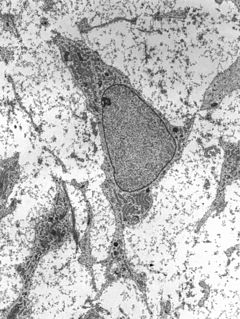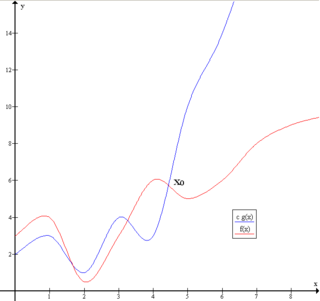
In mathematics, convolution is a mathematical operation on two functions that produces a third function that expresses how the shape of one is modified by the other. The term convolution refers to both the result function and to the process of computing it. It is defined as the integral of the product of the two functions after one is reversed and shifted. The integral is evaluated for all values of shift, producing the convolution function.

In multicellular organisms, stem cells are undifferentiated or partially differentiated cells that can differentiate into various types of cells and proliferate indefinitely to produce more of the same stem cell. They are the earliest type of cell in a cell lineage. They are found in both embryonic and adult organisms, but they have slightly different properties in each. They are usually distinguished from progenitor cells, which cannot divide indefinitely, and precursor or blast cells, which are usually committed to differentiating into one cell type.

Big O notation is a mathematical notation that describes the limiting behavior of a function when the argument tends towards a particular value or infinity. Big O is a member of a family of notations invented by Paul Bachmann, Edmund Landau, and others, collectively called Bachmann–Landau notation or asymptotic notation.

Christopher George Latore Wallace, better known by his stage names the Notorious B.I.G., Biggie Smalls, or simply Biggie, was an American rapper and songwriter. Rooted in the New York rap scene and gangsta rap traditions, he is widely considered one of the greatest rappers of all time. Wallace became known for his distinctive laidback lyrical delivery, offsetting the lyrics' often grim content. His music was often semi-autobiographical, telling of hardship and criminality, but also of debauchery and celebration.

In mathematics, a function is a binary relation between two sets that associates each element of the first set to exactly one element of the second set. Typical examples are functions from integers to integers, or from the real numbers to real numbers.

The Glyphipterigidae are a family of small moths commonly known as sedge moths, as the larvae of many species feed on sedges and rushes. More than 500 species have been described in the family.

In telecommunications, 5G is the fifth generation technology standard for broadband cellular networks, which cellular phone companies began deploying worldwide in 2019, and is the planned successor to the 4G networks which provide connectivity to most current cellphones. 5G networks are predicted to have more than 1.7 billion subscribers worldwide by 2025, according to the GSM Association. Like its predecessors, 5G networks are cellular networks, in which the service area is divided into small geographical areas called cells. All 5G wireless devices in a cell are connected to the Internet and telephone network by radio waves through a local antenna in the cell. The main advantage of the new networks is that they will have greater bandwidth, giving higher download speeds, eventually up to 10 gigabits per second (Gbit/s). Due to the increased bandwidth, it is expected the networks will increasingly be used as general internet service providers for laptops and desktop computers, competing with existing ISPs such as cable internet, and also will make possible new applications in internet-of-things (IoT) and machine-to-machine areas. 4G cellphones are not able to use the new networks, which require 5G-enabled wireless devices.

Cryptophlebia is a genus of moths belonging to the subfamily Olethreutinae of the family Tortricidae.
Ussara polyastra is a moth in the family Glyphipterigidae. It is known from South Africa.
Ussara semicoronis is a moth in the family Glyphipterigidae. It is known from Ethiopia.

Cryptophlebia repletana is a moth of the family Tortricidae. It is found in South-East Asia, including the Philippines, Sarawak, Taiwan, Fiji and Japan.
Ussara is a genus of sedge moths. It was described by Francis Walker in 1864.
Ussara ancobathra is a species of sedge moth in the genus Ussara. It was described by Edward Meyrick in 1932. It is found in Brazil.
Ussara ancyristis is a species of sedge moth in the genus Ussara. It was described by Edward Meyrick in 1920. It is found in Brazil.
Ussara arquata is a species of sedge moth in the genus Ussara. It was described by Edward Meyrick in 1926. It is found in Colombia.

Ussara chalcodesma is a species of sedge moth in the genus Ussara. It was described by Edward Meyrick in 1913. It is found in Guyana.
Ussara chrysangela is a species of sedge moth in the genus Ussara. It was described by Edward Meyrick in 1922. It is found in Peru.
Ussara hilarodes is a species of sedge moth in the genus Ussara. It was described by Edward Meyrick in 1909. It is found in Assam, India.
Ussara iochrysa is a species of sedge moth in the genus Ussara. It was described by Edward Meyrick in 1921. It is found on Java.
Ussara semmicornis is a species of sedge moth in the genus Ussara. It was described by Edward Meyrick in 1932. It is found in Ethiopia.









